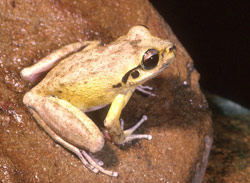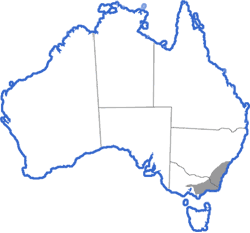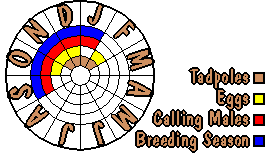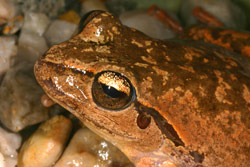Litoria lesueuri
Lesueur's Tree Frog
Also: Rocky River Frog, Stoney Creek Frog, Stony Creek Frog

+ 50 kb Lesueur's Tree Frog (Litoria lesueuri)
One of the largest of the "rocky river" frogs and a very strong jumper, this frog has on occasions been found long distances from water. It is locally common and its distribution extends from Western Victoria to the Hawkesbury River in New South Wales. This frog was previously thought to occur through northern New South Wales and Queensland but the northern populations were described as new species in 2004 - Litoria wilcoxi and Litoria jungguy.
Distribution and habitat

Adults can be found in both wet and dry forest and open areas but more commonly in association with running water. Eggs are laid in streamside pools and backwaters and the tadpoles are active swimmers in running water.
There is a detailed distribution map available for: Victoria.
Calling
Males usually call from rocks on stream or river banks. The call is a series of several similar short soft trills rapidly repeated - "creww crewwk crewwwwk crewwwwwk".
Copyright Murray Littlejohn. Recorded by Murray Littlejohn. Must not be reproduced without permission.
Life cycle

Distinguishing characteristics

+ 46 kb Lesueur's Tree Frog (Litoria lesueuri)
Adult
length: 30-55mm.
The eggs are pigmented in jelly clumps attached to vegetation or rocks, or floating. The tadpoles are light brown and the fins are yellowish with brown flecks. Adults have purple/black on the back of thighs and a black stripe passing through the eye and broadening over a distinct tympanum (ear).
Visible features
Presented here is the information stored in the frogs.org.au database which is used to identify frogs based on their appearance. It is intended to be used in a key guide for separating species so some of the information (for example, back colours) may be rather non-specific. The system is currently being developed - if you notice errors in the data, please write to Dave Black at the address at the bottom of the page.
Important note: This information details only the appearance of the frog. If an "or" appears in the description, this may mean either that there is some variation within the species or that the feature might be observed differently by different people. For example, if a frog has very small toe pads, it may be listed as having "Toe pads: present or absent".
Size
Up to between 30mm and 60mm
Eyes, hands, and feet
Pupils: horizontal
Toe pads: present
Webbing on feet: half-webbing
Belly
Texture: smooth
Pattern: plain
Colour: single colour
Back
Texture: smooth or rough
Pattern: plain or mixed / marbled
Colour: single colour or multi-coloured
Glands and tubercles
Parotoid gland: absent
Tibial gland: absent
Metatarsal tubercles: absent
Similar species (note: this version was written for Victorian species).
Distinguished from most other hylids (at least in Victoria) by the colouration on the thighs. May be easily distinguished from Litoria peroni (which has similar markings) by having a horizontal pupil.
Litoria lesueuri image gallery
Metamorphlings
The scientific names of Litoria lesueuri
- Hyla citripoda (Peron 1807)
- Hyla lesueuri (Dumeril & Bibron 1841)
- Ranoidea flavoviridus (Girard 1853)
- Euscelis lessonii (Fitzinger 1860)
- Litoria wilcoxii (Gunther 1864)
- Hyla (Litoria) freycinetii unicolor (Keferstein 1867)
- Hyla vinosa (Lamb 1911)
- Hyla kinghorni (Loveridge 1950)
- Litoria lesueuri (Dumeril & Bibron 1841)






















